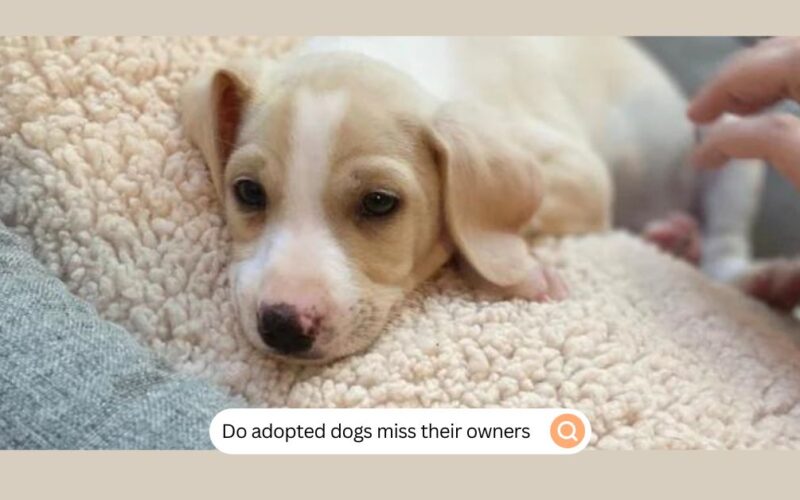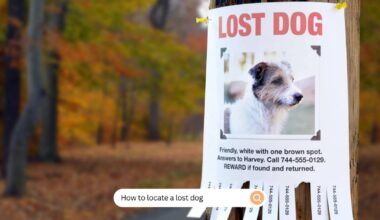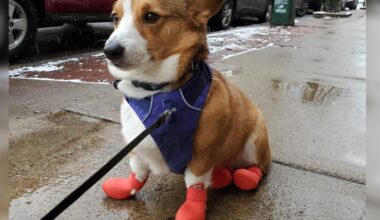About the Author: Jean Colt, a valued writer at MyPetDoggie and a dedicated student of English Literature at Yale University. Jean’s love for dogs, coupled with her literary skills, allows her to create engaging content that resonates with our pet-loving community. Her work reflects her passion for dogs and commitment to enhancing pet care knowledge.
When you adopt a new dog or give your dog for adoption a question always clicks your mind. Is he going to miss me or is he missing his previous owner? Or do adopted dogs miss their owners?
Well, there is proof that dogs do miss their owners when given away. Some become depressed and take time to recover and settle down in their new environment while others can just adjust easily in a few days. It depends on various factors like age, breed, past experiences, and so on. So, let’s have a detailed discussion on this topic.
Do Adopted Dogs Miss Their Owners?
Yes, adopted dogs do miss their previous owners but with time passing they will adjust and be happy with their new family. If they have really strong bonds with previous owners it can be hard for them to adjust to the new place. As dogs are capable of forming deep emotional attachments with their human companions.
The sudden changes in dogs lives can be a bit stressful for them.
Unfortunately, a lot of dogs have to relocate for different reasons. It can be a change in their health or it can be a change in a family’s living or financial situation. Maybe a new member in the family can have an allergy or it can be that the owner can no longer take care of a dog. Different owners wonder if their dogs are going to miss them.

But an important thing to keep in mind is that every dog has its personality and history which can influence their reaction to being adopted. It is possible that some dogs can quickly adapt and bond with their new owners but some dogs can take a long time to adjust after relocating. Before adopting a dog you have to keep in mind that it requires a lot of patience and understanding and providing a nice environment to help them adjust.
You can build a strong bond with adopted dogs with consistent care and positive interactions and training can help them to overcome any feelings and loss they have in heart and mind and help them settle into their new home more smoothly. If you are planning to adopt a dog, be prepared to invest time and effort into helping them adjust and providing the love and support they need during the transition.
How Long Can a Dog Remember?
It can depend on different factors which include the significance of an event or information and an individual’s cognitive abilities. Generally, a dog has a relatively good memory for different things but it is not as long-lasting or detailed as human memory.

Short-term memory:
Dogs can remember any event that has happened recently usually within minutes to several hours. For example, usually during training owners give dogs treats after they perform a trick, they can associate the action with a reward.
Long-term memory:
Dogs can also retain information that happened a long time ago but the accuracy and duration can be more variable. They can remember their training, commands, and also some experiences over days, months, and even weeks.
Associative memory:
It is known that dogs have a strong ability to associate objects and places with specific kinds of outcomes. If a certain place or object is associated with a positive experience like getting a treat or having an outdoor activity they can remember this connection with a good amount of time.
Emotional memory:
Dogs also have a remarkable ability to remember emotional experiences. Usually, they can remember people, animals, or situations that can make them feel happy, and fearful or give them anxiety.
Social memory:
It has been observed that dogs can remember other dogs and people after a long period of separation. It can be seen in their interactions with familiar individuals or animals after they are apart for a while.
It is an important thing to keep in mind that the dog’s memory is shaped by experiences and also what is relevant to their daily life. Their memory abilities can not match humans but certainly, they possess memory capabilities that play a role in their behavior and interactions.
You might be interested in: Discover essential information and considerations to be aware of before adopting a dog to ensure a successful and happy adoption
What is Semantic Memory in Dogs?
Semantic memory is a type of long-term memory that involves the storage of general knowledge, facts, and concepts about the world. It is a part of memory that allows us to understand language, recognize objects, and also have knowledge about different topics without necessarily remembering specific circumstances of how we have learned that information. It is very different from episodic memory which involves recollection of specific events and personal experiences.

The concept of semantic memory is still a topic of debate among scientists. Humans and dogs do not have the same language and cognitive capacities but there is evidence to suggest that they possess some level of semantic memory-like abilities.
Some examples of semantic memories are:
Commands and actions:
Dogs can learn and remember commands and associated actions even if they do not remember the context or training session specifically. For instance, a dog can remember the command to sit and perform the desired actions but he does not remember when, where, and how he learned it.
Object recognition:
Dogs can recognize and remember people, animals, and other dogs they have interacted with in the past even when they meet them after long periods of separation.
Social relationships:
Dogs can always remember and recognize familiar people, even if they meet after a long period they will still be able to recognize them.
Routine behaviors:
Dogs can learn routines and patterns in their everyday lives like they know when it is time for a meal or a walk.
Spatial memory:
It is noticed that dogs remember the layout of their environment which includes locations of food, water, and also their favorite spots.
The extent and nature of a dog’s semantic memory is still under research. They do not have the same depth and complexity of semantic memory as humans but their ability to acquire and retain information about objects, actions, and relationships is a fascinating area of research in the field of canine cognition.
How does a dog react to a new owner?
The reaction to a new owner varies from dog to dog based on their temperament, their past experiences, and how their new owner approaches them. We all have a question: do adopted dogs miss their owners and we usually get answers when dogs meet their new owners? Some common reactions you might see when the dog is introduced to a new owner are:

Excitement and Tail wagging:
Some dogs are usually friendly in nature and outgoing. They can approach their owners with enthusiasm, wagging their tails, jumping around, and showcasing happiness.
Caution and shyness:
Some dogs are not very friendly as they are shy and reserved. If they have had limited socialization or have experienced any kind of trauma in the past then they are not going to be very expressive.
Curiosity:
Dogs are very curious by nature. They can meet their new owner by sniffing and exploring. With time they can develop a deeper attachment to their new owner through positive interactions and also care and consistency.
Attachment and bonding:
We know that dogs can form strong emotional bonds with their owners and over time they can develop deeper attachments to owners through positive interactions along with consistency and some care.
Anxiety or fear:
There are some cases particularly if dogs had negative experiences with humans in the past they can show signs of anxiety or fear. The signs are trembling, cowering, or avoiding direct contact.
Indifference:
Dogs can show a lack of interest in people they are meeting for the first time especially if they do not have extensive socialization.
Tailored responses:
Different dogs have different kinds of personalities and they react based on their traits. Some of them are more outgoing and sociable but others might be more reserved and cautious.
As humans, we all know that building trust takes a lot of time, patience, and respect. If they have experienced any kind of past trauma it can affect their behavior a lot. It would be better if you could provide a calm and positive environment. You can use positive reinforcement techniques and treats and also give the dog some space to acclimate. Always make sure to observe their body language and then respond to them accordingly so you can build a positive transition.
You might be interested in: Explore the factors that determine how big of a dog an owl can pick up and ways to protect your pet from potential threats
How to Make Your New Rescue Comfortable
It is hard to make a new rescue dog comfortable in your space as it requires lots of time and patience. Take little steps towards helping them some steps you can take to help them adjust and feel at ease are:

Give them space:
When you bring them to your home first make sure to give them a quiet and designated area where they can retreat to if they are feeling overwhelmed. It can be a crate, a cozy bed, and maybe a specific room. Always make sure they have access to water, food, and a comfortable resting place.
Slow introduction:
Introduce your rescue dogs to their surroundings slowly. Allow them to explore at their own pace. Do not introduce them to all new things at one go this can be overwhelming for them.
Quiet environment:
Make sure that dogs have a calm and quiet environment so that your dog can feel safe. Make sure to avoid loud noise and sudden movements as this can scare them.
Establish a routine:
It is great to have a routine for dogs so try to establish a consistent and daily schedule for them. It can include feeding, walking playtime etc. This will help them feel safe and secure.
Positive reinforcement:
Use positive reinforcement techniques to build trust and reinforce positive behavior. Make sure to reward your dog with treats and praise and also be gentle with pets when they exhibit behaviors you want to encourage.
Respect personal space:
Rescue dogs take time to approach and interact with you on their terms. This avoids forcing physical contact or overwhelming them with some attention.

Patience and time:
All the dogs need time to adjust according to their own pace. It can take days, weeks, and even months. Make sure to give them space to acclimate so be patient and allow them the time they need.
Socialization:
Gradually and slowly introduce your rescue dog to other people and dogs. Make sure that these interactions are positive and are controlled to help build their social confidence even more.
Training and Enrichment:
Always engage your dog in positive training sessions and provide them with mental enrichment by using puzzle toys, games, and other activities. This way mental stimulation can help alleviate stress and boredom.
Veterinary Care:
When you rescue a dog it is important to schedule an appointment with your vet to ensure what is the physical and mental condition of your dog and then treat them accordingly.
Consistent Caregivers:
During the initial days, it is important to have a consistent routine and caregivers this will help the dog to build familiarity and trust.
Gentle handling:
During any kind of sudden movements approach your dog calmly. Gradually introduce grooming and handling. Teach him basic commands to build more trust and familiarity.
But the most important thing we have to remember is that every dog is unique and the thing which influences them is their background along with temperament. Be observant with their body language and then make sure to adjust properly. Always consider the comfort of a rescue dog first before doing any kind of new activity. Building a strong bond of love between yourself and a rescue dog requires lots of patience, love, and a supportive atmosphere. If you are encountering any kind of challenges make sure to seek guidance from professional dog trainers or behaviorists who are experienced with rescue dogs.
Tips for Strong Bonding with Your Rescue
A few important tips you need to keep in mind while bonding with your rescue dog are:

Give Them Time and Space:
Make sure to respect your rescue dog for adjustment. You have to allow them to explore their surroundings and approach them at their own pace.
Be Patient and Understanding:
Understand the previous experiences your dog had and they influenced your dog’s behavior. The most critical factors are patience and empathy for building trust with a rescue dog.
Positive Reinforcement:
Always use treats, praise, and rewards to reinforce more positive behaviors. It can help your dog associate with positive experiences.
Spend Quality Time Together:
Dedicate time for walks, play, and relaxation. Make sure to engage in activities that promote bonding and will help you create more positive memories.
Practice Obedience Training:
It is important to teach them basic commands like sit, stay come, etc This will help them to establish communication ways between you and them. It also helps in building a sense of cooperation.
Socialization:
Expose your rescue dog to a new environment, people, and animals very slowly. It should be done in a controlled and positive manner. Always see their body language if you feel that they are not getting anxious or are scared then you can increase the time more otherwise prefer to take things slow.
Respect Their Boundaries:
Make sure to observe their language and reactions also allow them to initiate interactions and make sure to respect their comfort levels with physical contact.
Gentle Physical Contact:
Always use gentle touch and massages to create positive associations with physical contact. This way they can be more comfortable with you and it can help you bond more quickly.
Provide Mental Stimulation:
You can offer them toys and puzzles or any kind of interactive games that can keep them mentally engaged and strengthen their bond.
Remember that every dog is unique and you have to adapt these tips according to the personality of your dog. It takes time and effort to bond with rescue dogs but the rewards are well worth it can be in the form of trusting and loving relationships.
Signs a Dog Misses their Previous Owner
Some common signs that an adopted dog is missing their previous owners are:

Whining or Howling
If you are observing excessive vocalization like whining or growling then it can be a way for dogs to express distress or anxiety. Make sure to take care of them when you observe this kind of behavior.
Lack of Appetite
One of the common signs that a dog is missing their previous owner or maybe feeling stressed is that they stop eating. You can see that they have decreased interest in food.
Lethargy
Dogs who are missing their previous owner and families can become more lethargic or can be less interested in activities they used to enjoy previously.
Searching Behavior
If you see them searching around, roaming here and there, or looking for familiar scents or cues then it is a sign that they are missing someone.
Pacing or Restlessness
If you see your dog in a panic situation or inability to settle down then this could indicate anxiety and it can be a sign of missing someone.
Increased Clinginess
Sometimes when dogs miss their previous owners they become more clingy and seek more physical contact and reassurance. At this time make sure to provide them the attention and love they need. This can comfort and soothe them. Taking them out for a walk can also help.
Change in Behavior
Any kind of change in behavior like becoming withdrawn or even more excitable can be a sign of emotional adjustment.
Hesitance to Engage
If a dog misses their previous owners then they can be hesitant to engage with new people and activities in a new environment.
Anxious Behaviors
If you see different signs of anxiety like excessive panting, trembling licking, etc. then it can be a response to missing any familiar person. Make sure to shower them with love and cuddles so that they can sooth down.
Remember that these signs can indicate stress; it can also be caused by several other reasons. Every dog is different and their reactions to different situations are also different. Patience and understanding will help you to create a stress-free, secure, and loving environment.
Should I stay in contact with my dog’s previous owner?
It depends on several factors and also includes the circumstances of adoption and the dog’s well-being. Some considerations are:

Transition period:
In the initial transition period, it can be beneficial to have some contact with the previous owner especially if your dog is very stressed and anxious. It can help in the reassurance of dogs and help in making transitions more smoother.
Dog’s comfort:
If you see that your dog is missing their previous owners the signs are explained above then check if the previous owner is open to it then occasional visits or updates could ease your dog even more for their emotional adjustment.
Distress vs. Moving on:
Too much contact with the previous owner can also hinder a dog’s ability to bond with you and adapt to a new environment. It is very important to strike a balance between helping dogs transition and allowing them to form new attachments.
Respect the dog’s needs:
Monitor the behavior and emotions of your dog. If you think that staying in touch with previous owners seems to prolong stress then you can limit it gradually and then after some time without contact.
How Long Does it Take for a Rescue Dog to Adjust?
It takes some time for rescue dogs to adjust and it depends on various factors:
Background:
The past experiences of dogs play a significant role. If your dog has a traumatic past then he needs some extra time to adjust.
Temperament:
Dogs are different from each other; some are naturally resilient and adaptable while others can be more sensitive and take longer to adapt to a new environment.
Socialization:
The level of a dog’s socialization and exposure to different environments can impact its speed of adjustment.
Consistency:
A few things that can help them adjust are a stable routine, positive reinforcement, and patient guidance.
Individual differences:
Some dogs will adjust in just a week while others may take months to adapt to the new environment.
How Long Do Dogs Miss Their Old Owners?
Adopted dogs can miss their owners for different durations and often it depends on what kind of bond they share with their previous owner.
Initial period:
In the first few days after adoption, the dogs can show signs of missing their previous owners due to sudden changes.
Attachment to a new owner:
Dogs form a bond with you and then experience positive interactions they are more likely to shift their focus and attachment with time.
Individual variability:
It takes weeks for some dogs to acclimate while others can take months to fully adjust and adapt to the new environment.
Positive Associations:
Engaging in different kinds of activities, and giving them rewards and treats help in creating positive memories together this will help the dog to associate happiness with a new home and owner.
Remember that patience, consistency, and understanding along with a stable environment are the key components to help a rescue dog adjust and form bonds. If you are concerned about your dog you have to take care of him and help him consistently.
Common Question:
Should you change a rescue dog’s name?
If your dog responds to that name then we recommend keeping the name initially. However, if you feel that dogs have a negative association with their old name then you can give them a fresh start by giving them a new name. Just make sure that the new name sounds very different from the old one to avoid any kind of confusion.
What is the rule of 3 for rescue dogs?
It is a guideline for helping dogs and settling them into new homes. It involves three days to decompress and adjust without overwhelming them with any new experience. Then after three weeks, a routine should be established to build trust. Finally, after three months, the dog will be fully acclimated.
What do dogs think when they are lost?
It is not possible for us to know what they are exactly thinking but dogs are likely to experience fear, stress, and tension. This can lead them to find similar scents and landmarks. They can be seen as anxious and disoriented when they are separated from their human companions.
Do dogs think of us as parents?
They can not take the relationship with humans as a parent-child the way we do it. However, they form a very strong bond with their caregivers and see them as providers of care and safety.
Is it cruel to rehome a dog?
It is a difficult decision but not cruel if it is done with care and responsibility keeping the dog’s condition in mind. There can be different valid reasons like changes in owners’ circumstances or well well-being of a dog.
Do rescue dogs love you more?
Rescue dogs show a lot of attachment and gratitude but it is not accurate to say that they love their new owners universally. Every dog is an individual and their capacity to bond and love depends on various factors.
Do dogs recognize their former owners?
They have a great sense of smell and memory. They might recognize the presence of their former owners after separation but this is based on their experience and duration.
Many dogs are relocated for various reasons and a lot of dogs are abandoned or given away to shelters every year. So owners wonder whether the dog is gonna miss them or not. After reading this article you surely know that yes they are going to miss their owners but gradually they are going to adjust into the new environment. They are going to live a happy and healthy life once again in a few months.






![Should I Let My Other Dog See My Dead Dog [Answered]](https://mypetdoggie.com/wp-content/uploads/2024/02/Should-I-Let-My-Other-Dog-See-My-Dead-Dog-Answered-380x220.jpg)